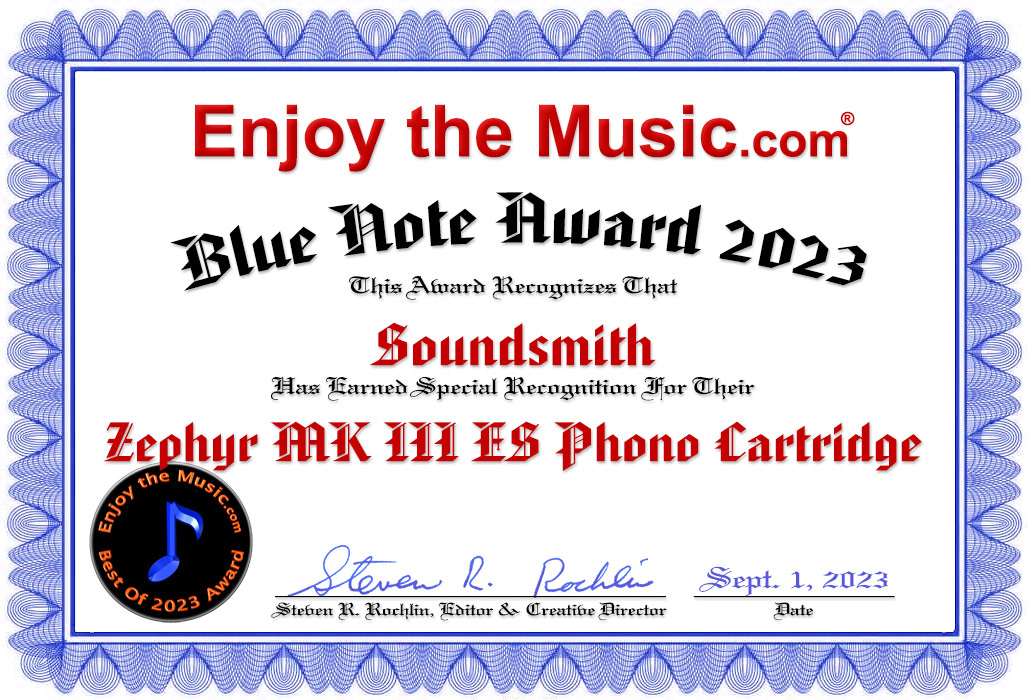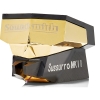Soundsmith Strain-Gauge Cartridge And Phono Preamp (TAS 201)

In short, this is one of the handful of high-end products so good and so different, it really is worth serious travel to hear.
- Anthony Cordesman, The Absolute Sound
I tend to be cautious in praising a cartridge. I used to do pickup surveys in the era when the LP dominated high-end listening, and it was all too apparent that the best moving coils often diverged in ways that were more matters of personal taste than of merit. Each would reveal slightly different details in recordings, many of which bore little resemblance to the differences you hear in live music. Plus minor changes in setup, cartridge loading, and tonearm position could be as important as the inherent variability of the cartridges themselves. Exotic mounting techniques, shells, cantilevers, and styluses also made real sonic differences. When these changes were musically realistic, they were the kind of thing you’d hear when going to different concerts halls or venues, or shifting from the front to the rear of the hall.
After decades of listening and reviewing, I find that the best systems are not centered around the best cartridge, but rather around the most synergistic blend of the remaining colorations in the cartridge, the speaker, and the rest of the system in a listening space where the audiophile has made careful adjustments for the interaction between speakers and room. The game of audio is won by patient tailoring of components to produce this synergy in listening to LPs—sometimes at the cost of equal performance with the different sound of digital. This synergy is, also, often genre specific. A system tailored to chamber music may not be as good with full orchestral music and rarely is as good with rock or big band jazz.
Yet, sometimes a cartridge and front-end electronics do make differences that matter more than the usual differences between moving coils and moving magnets. This was very clear in listening to the Soundsmith strain-gauge cartridge. For all the added sophistication and cost of other cartridges over the last few decades, this is the first product that I have heard in years that really does makes an audible, musically convincing difference in the sound you hear playing LPs.
I’m not going to call the Soundsmith strain gauge a “breakthrough.” In fact, strain-gauge cartridges have been around for decades. (Sao Win and Panasonic sold cartridges with strain-gauge technology in the past.)
The Soundsmith strain-gauge cartridge is far more advanced in sound quality than what I remember of those products; it is an extraordinary combination of a brilliantly engineered cartridge and dedicated phono electronics that act as the equivalent of a phono preamp. All of the Soundsmith “preamp” models offer at least one line input, allowing the user to “touch-switch” between the SG function and a line source. As a result, since all models also feature fixed and variable, balanced and unbalanced outputs, they can serve as the system preamp as well.
I also am scarcely going to recommend that every high-end audiophile who loves LP should rush out and buy one. To start, the prices range from $7500 to $15,000. There are good-to-very-good cartridge and phono preamp combinations that sell for $300 to $500. There also are great top-of-the-line moving coils, moving magnets, and moving irons that sell for much less than a strain-gauge setup.
However, after several months of intensive listening, I did find that a properly set-up Soundsmith strain-gauge cartridge and electronics offered the cleanest and smoothest upper octaves, the lowest noise, and the best-defined soundstage I have yet heard from any system designed to reproduce records. I can also guarantee you that even if you totally disagree with me about the Soundsmith’s merits, you will discover a truly different approach to LP sound—one that will reshape your perceptions about what LP can and cannot do.
Before I get to the details of this sound quality, a brief discursion into strain-gauge technology. This technology has not really been on the market since the glory days of analog and I suspect few modern audiophiles are familiar with it. In brief, a strain-gauge cartridge uses the cantilever to put pressure on two sensitive silicon crystal pieces that change in resistance as the cantilever moves with the modulation of the groove. The preamplifier, which is integral to the process, delivers a current that flows through the silicon crystals. The crystals’ changing resistance modulates the current flow through them, creating the audio signal.
Unlike other cartridge designs, the cantilever does not have to drive coils or the equivalent of a generator. There is minimal effective mass, very extended frequency response, and no generation of the kind of resonances that either create peaks and problems in the upper-frequency response of most moving-coil cartridges or require the cantilevers to be overdamped and the cartridges less “live” and detailed.
As for the full technical merits of this approach, I am a cartridge listener and not a designer. Peter Ledermann, the designer of the Soundsmith strain-gauge system, put it this way when I asked him for more detail:
If one looks at the cantilever as a lever, stuck into a relatively large mass (moving coil, moving magnet, moving iron), one can imagine the energy from the stylus moving up the cantilever and trying to move the mass. It can’t do so perfectly, so lots of the energy reflects back down the cantilever, causing distortion.
The SG system has little or no moving mass by comparison; only a damping termination for the trapped end of the cantilever. It works so well that very little energy gets reflected back down towards the stylus. It gets “damped out” at the top. In fact, the energy that gets damped out is used in the SG system to activate the strain-gauge elements. Energy that would normally be wasted or reflected back is put to use to generate the replica of the original waveform as represented by the groove modulations.
The benefits of lowering the moving mass are many and significant. It results in far higher natural “resonant frequency” of the moving mass which means lower groove noise due to the natural jitter of the stylus being raised to 130–150kHz, rather than 30–50kHz like many mc cartridges. It provides far greater sonic micro-detail resolution due to dramatically reduced stylus jitter, and much more effective system damping of the stylus due to vastly reduced moving mass. There is no “generating magnetic system” to move about. This results in greater statistical contact of the stylus with the groove walls, which translates into greater resolution—lots of micro-detail.
This, in conjunction with other technical differences, makes the strain-gauge stylus far more accurate in reading what’s on the groove walls. If one considers that all styli “jitter” as they make their way down the groove, it means that even in vinyl reproduction, one is “sampling” the analog signal! Less jitter equals much better sampling.
The system also has low phase shift and ultra-clean transient capability (fast, controlled response time). It can reproduce a square wave with remarkable accuracy, unlike other cartridges. There are only 10 degrees of phase shift in the audio band.
I’m no cartridge designer, so I can’t endorse these claims, and I normally avoid manufacturer hype. What I can say is that the Soundsmith strain gauge does justify Peter’s claims to the extent that it is a truly superb-sounding product. Moreover, I was continuously impressed by the sounds it didn’t make.
One way or another, we are all conscious of the “sound of silence” in top components. In the case of a phono front end, this is the ability of a cartridge and phono preamp to eliminate extraneous noise and reproduce only what is on the record. If one treats the Soundsmith strain-gauge cartridge and electronics as a “system,” it is the most noise-free I have yet heard. No hum, no circuit noise, and there is a muting system that totally cuts out the signal when the cartridge is not playing. This latter feature eliminates a barely perceptible, almost subliminal level of noise that hardly matters with the best alternative cartridges and phono preamps but is still vaguely there.
Don’t get me wrong about this “silence.” If there is tape hiss on the LP, the Soundsmith will do a superb job of reproducing it. If it seems to reduce record noise and pops in comparison with many competing cartridges, this is because it does not exaggerate any part of the upper octaves and is so fast and detailed. It is not warm and it does not romanticize any part of the treble or upper midrange. It does get all of the musical information out of the record without producing the kind of rise and resonances in the upper octaves that are inevitable in all moving coils that attempt to be flat. Moreover, there are truly exceptional air, life, and musical excitement throughout the midrange and treble. If you have always wanted the smooth upper octaves of moving magnets and moving irons, and the life and dynamic energy of moving coils, the Soundsmith system will probably be the cartridge and front end electronics you have been looking for.
It doesn’t really matter what kind of music you pick, but if you are into natural acoustic sound, woodwinds, strings, brass, and female and male voice come through with exceptional realism. This also makes a difference with “difficult” instruments. The same harpsichord recording that most good moving coils harden, and most good moving magnets slightly deaden, will turn out to sound quite musical.
The Soundsmith setup produces one of the, if not the, most detailed and three-dimensional soundstages I have yet heard in equipment designed to reproduce LPs. It reveals all of the detail in the usual studio efforts to fake a stage, but it also does a superb job of revealing the soundstage on the older RCA, Everest, and other classic records that used simpler miking and did not use multiple dubs and tracks. It won’t add what isn’t there, and plenty of analog records are only two-dimensional. With good LPs, however, the combination of detail, low-level dynamics, overall dynamic range, and natural timbre can be extraordinarily revealing.
The Soundsmith shows that a properly mastered LP and digital recording off the same mastertape can be remarkably alike. I much prefer the best in LPs to conventional CDs, but it is a much closer call with the best SACDs and new high-resolution DVDs and downloads. With the best LPs, the Soundsmith keeps things competitive with the best DVDs; few of even the best cartridge and phono preamp combinations now do.
The Soundsmith strain gauge also does very well from the lower end of the midrange down to the deepest bass. This is not a cartridge that is bothered by loud deep bass dynamics. Trot out your Telarc bass drum LPs. Let the godawful nature of Saint Saëns’ Symphony No. 3 come through in all of its infamy in any LP version you can find. Make bass guitar and synthesizer LPs roar to the point where they further damage your hearing. No problem! In fact, like a few other top cartridges, the strain gauge does more to expose the dynamic limits of the bass cut into most LPs than any limits of its own.
As to how good the Soundsmith’s bass really gets, I intend to find out with a different arm in the future. I suspect it would do even better with a lower mass arm than I had available. Peter Ledermann set up the cartridge under tight time pressure, and did so in a VPI 12.5” arm that is excellent for moving coils, but a bit too massy for the strain gauge. Tracking was still outstanding, and bass response was competitive with the most expensive moving coils, but I’m sure a lower mass design would be even better.
Do I have any sonic reservations about the Soundsmith? A few. The Soundsmith strain gauge does not use a technology that requires equalization, and Peter Ledermann has chosen to go for transparency and dynamics, and to avoid problems in phase and time shifts, rather than to add an equalization circuit to create an exact match to the RIAA curve in frequency response. He notes: “The beauty of the SG system is that there is one flat gain stage between the vinyl and you—part of the listening result is due to that. By eliminating the multi-stage filtering circuit that all other cartridges require, something important is gained, far outweighing what may be lost by not having ‘perfect’ amplitude response. We are typically +/-1dB from 50Hz–12kHz—not bad for this type of system. Above and below that, the arm-effects that plague all types of cartridges enter into play. Much is gained by being able to employ an elegant, ultra-low-phase-shifted, ultra-low-distortion single gain stage.”
In my particular setup, tonearm variability may have made sound just a little short of the ideal in terms of lower midrange richness and energy.
The fact that the electronics do not need equalization also means that you can’t adjust for earlier LP and 78 equalizations, or the various companies that never fully adopted the RIAA curve. But very few modern phono preamps allow this, either. Otherwise, you need to buy an outboard phono equalization unit and this can present sound quality problems of a different kind.
I also have a reservation about cost, although it is purely a selfish one. I can’t afford to buy a Soundsmith as my reference at this particular moment of financial turmoil. This not only makes me jealous because of the Soundsmith’s sound, but also because I can’t take advantage of the Soundsmith’s “glitter factor.” The system may be pricey—even by high-end standards—but the actual cartridge is superbly made and shows it. The cartridge actually has built-in azimuth and VTA adjustments. It has a reliable changeable stylus with a wide range of optional stylus tips. And there is a cool, built-in, blue LED display in the front of the cartridge to show the electronics are active.
The actual electronic units come in a wide variety of packages that you need to check out on the Soundsmith Web site. The more expensive ones, however, have even more “glitter factor” than the cartridge. They are full-function preamps with added analog inputs and with balanced and unbalanced outputs. They have an attractive retro-wood cabinet that gives a nice period cast to a device for LP listening.
Above all, they have functional LED displays that would make a Mighty Wurlitzer cringe in shame. You don’t just get a three-color power-status display (which you can dim or turn off); you actually get separate LED displays of vertical tracking force, and of whether the tracking weight insures proper contact with a warped record, Additionally, you get a “force per groove wall display” that will warn if the record hole is punched off-center or you don’t have the right skating force.
You don’t need to make this kind of investment. If you only care about sound quality, the cheapest version of the Soundsmith will sound exactly like the most expensive. If, however, you want electronics that can be used as a preamp directly with your power amps, the higher cost units add that function. And if you want to upstage other high-end audiophiles, buying the higher-cost electronics will give unique audio status appeal. Who else will have a phono front end with interactive readouts? (Not that any reader of this magazine ever dreamed of one upping another audiophile—ever!)
In short, this is one of the handful of high-end products so good and so different, it really is worth serious travel to hear. Oh, and it is also one of the few phono front ends ever to be sold with a really good instruction manual. You’ll still benefit from the help of good dealer setup, but the strain gauge’s exotic technology does not mean that any experienced audiophile will have problems in doing his own setup—if he actually reads and obeys the instructions.
SPECS & PRICING
Soundsmith Strain-Gauge Cartridge and Phono Preamp
Weight: 9.8 grams
Compliance: 20
Recommended tracking force: 1 gram to 2.5 grams; 1.9 grams recommended
Dimensions: All preamplifier models are 16” x 16” x 3.5” high; external power supply is 8” deep x 3” tall x 6” wide
Prices: SG-810 (full display features, 5 line input w/tape monitor, remote controlled), $14,999; SG-610 (full display features, one line input, remote controlled), $12,499; SG-600 (full display features, one line input), $11,499; SG-510 (Five line inputs w/tape monitor, remote controlled), $12,499; SG-500 (Five line inputs w/tape monitor), $11,499; SG-410 (One line input, remote controlled), $8499; SG-400 (One line input), $7499








